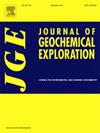大兴安岭南缘布金黑铅锌矿床:还原热液脉型铅锌矿化体系的一个例子
IF 3.3
2区 地球科学
Q1 GEOCHEMISTRY & GEOPHYSICS
引用次数: 0
摘要
布金黑矿床位于大兴安岭南缘西坡,是一个典型的脉状铅锌矿化矿床。布金黑矿体主要赋存于二叠系沉积岩中,受近ew向断裂的构造控制。热液脉体中可识别出3种类型的流体包裹体,即气液两相包裹体(1型)、富CH4(±CO2)包裹体(2型)和纯CH4-CO2包裹体(3型)。激光拉曼光谱分析进一步证实了这些流体包裹体的气相中含有大量的CH4。岩石学、显微测温和流体包裹体激光拉曼光谱分析表明,成矿流体为NaCl-H2O-CH4±CO2体系,具有中等温度、低盐度的特征。含矿脉石英和碳酸盐的氧、氢同位素数据介于典型岩浆水和大气水之间(δ18Ofluid = 4.0‰~ 7.2‰,δDfluid = - 123.1‰~ - 112.7‰)。布金黑流体的δ流体值极低可能是由于矿石流体与碳质地层发生水-岩反应所致。流体包裹体CH4的δ13C PDB值在−31.8‰~−27.9‰之间,表明成矿流体参与了沉积有机质的水解作用。布金黑硫化物δ34SCDT值限制在−3.2 ~−0.7‰,无沉积硫的诊断特征。这些硫化物分别为206Pb/204Pb = 18.200 ~ 18.285、207Pb/204Pb = 15.519 ~ 15.623、208Pb/204Pb = 38.020 ~ 38.364,与大部分热液脉型矿床重叠,主要来源于深部岩浆。布金黑铅锌矿床具有典型的还原性热液系统特征,其成因可能与岩浆有关,并受减碳岩的强烈影响。本文的研究结果有力地证明了碳质围岩对大兴安岭南部铅锌成矿热液系统还原条件的形成具有重要影响。本文章由计算机程序翻译,如有差异,请以英文原文为准。
The Bujinhei Pb-Zn deposit in the southern Great Xing'an Range, China: An example of the reduced hydrothermal vein type Pb-Zn mineralization system
The Bujinhei deposit, a representative vein-type Pb-Zn mineralization, is situated on the western slope of the southern Great Xing'an Range (SGXR). The ore bodies of Bujinhei are primarily hosted within Permian sedimentary rocks and structurally controlled by nearly EW-trending faults. Three types of fluid inclusions (FIs), including gas-liquid two-phase inclusions (Type-1), CH4 (±CO2)-rich inclusions (Type-2), and pure CH4-CO2 inclusions (Type-3) can be recognized in hydrothermal veins. Laser Raman spectral analysis further confirmed that the gas phase of these fluid inclusions contained large amounts of CH4. Petrographic analysis, microthermometry, and laser Raman spectroscopy of fluid inclusions suggest that the ore-forming fluids comprise a NaCl-H2O-CH4 ± CO2 system, characterized by moderate temperatures and low salinity. Oxygen and hydrogen isotope data for quartz and carbonate from the ore-bearing veins fell between the fields of typical magmatic and meteoric water (δ18Ofluid = 4.0 ‰–7.2 ‰, δDfluid = −123.1 ‰ to −112.7 ‰). The extremely low δDfluid values of Bujinhei fluids could be due to water-rock reactions between ore fluids and carbonaceous strata. The δ13C PDB value of the CH4 in fluid inclusions ranged from −31.8 ‰ to −27.9 ‰, also suggesting the hydrolysis of organic matter in the sedimentary was involved in the mineralizing fluids. Sulfides from the Bujinhei show restricted δ34SCDT values of −3.2 to −0.7 ‰, without the diagnostic signature of sedimentary sulfur. These sulfides have 206Pb/204Pb = 18.200–18.285, 207Pb/204Pb = 15.519–15.623, and 208Pb/204Pb = 38.020–38.364, overlapping with most of the hydrothermal vein type deposits, which were sourced primarily from deep-seated magma. Genetically, the Bujinhei Pb-Zn deposit shows characteristics of a typical reduced hydrothermal system, which may be originally magmatic-related and dramatically influenced by carbonaceous-reducing rocks. The investigation results presented in this paper provide compelling evidence that carbonaceous wall rocks exert a substantial influence on the formation of reducing conditions in lead‑zinc ore-forming hydrothermal systems in the southern Great Xing'an Range.
求助全文
通过发布文献求助,成功后即可免费获取论文全文。
去求助
来源期刊

Journal of Geochemical Exploration
地学-地球化学与地球物理
CiteScore
7.40
自引率
7.70%
发文量
148
审稿时长
8.1 months
期刊介绍:
Journal of Geochemical Exploration is mostly dedicated to publication of original studies in exploration and environmental geochemistry and related topics.
Contributions considered of prevalent interest for the journal include researches based on the application of innovative methods to:
define the genesis and the evolution of mineral deposits including transfer of elements in large-scale mineralized areas.
analyze complex systems at the boundaries between bio-geochemistry, metal transport and mineral accumulation.
evaluate effects of historical mining activities on the surface environment.
trace pollutant sources and define their fate and transport models in the near-surface and surface environments involving solid, fluid and aerial matrices.
assess and quantify natural and technogenic radioactivity in the environment.
determine geochemical anomalies and set baseline reference values using compositional data analysis, multivariate statistics and geo-spatial analysis.
assess the impacts of anthropogenic contamination on ecosystems and human health at local and regional scale to prioritize and classify risks through deterministic and stochastic approaches.
Papers dedicated to the presentation of newly developed methods in analytical geochemistry to be applied in the field or in laboratory are also within the topics of interest for the journal.
 求助内容:
求助内容: 应助结果提醒方式:
应助结果提醒方式:


